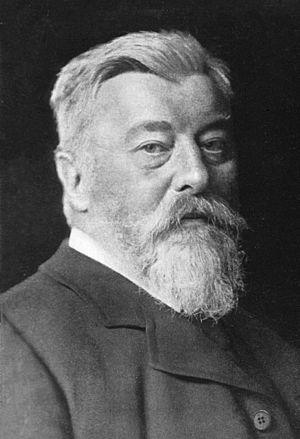W. H. Gaskell facts for kids
Walter Holbrook Gaskell (born November 1, 1847, in Naples; died September 7, 1914, in Great Shelford) was a very important British scientist. He was a physiologist, which means he studied how living things, especially the human body, work. He made big discoveries about the heart and how our bodies control it.
Contents
Early Life and Education
Walter Gaskell grew up as the son of John Dakin Gaskell, who was a lawyer. He went to school at Highgate School. Later, he studied at Trinity College, Cambridge, a famous university. In 1869, he earned his degree. He was even called a "wrangler," which means he was one of the top math students. After that, he became a Fellow at Trinity Hall.
Amazing Discoveries About the Heart
Walter Gaskell worked in the science lab at the University of Cambridge. He spent most of his time studying the heart and how our blood vessels and nervous systems work. His research was super important for understanding how the heart functions.
He made several key discoveries:
- He figured out the order in which the heart muscles contract.
- He showed that the heart is controlled by two different parts of the autonomic nervous system. These parts either speed up or slow down the heart.
- He introduced the idea of heart block. This is when the electrical signals that make the heart beat are slowed down or blocked.
- He proved that the heartbeat starts in the heart itself, not from outside signals. This is called the myogenic origin of the heartbeat.
His work also helped other scientists study problems with heart rhythm, known as cardiac arrhythmias. He also made progress in mapping the sympathetic nervous system. This part of the nervous system helps control our "fight or flight" response. In 1881, he was the first to explain how the acidity (pH) outside cells affects the heart and blood vessels.
Awards and Recognition
Because of his amazing work, Walter Gaskell was chosen to be a Fellow of the Royal Society in 1882. This is a very high honor for scientists in Britain. He also gave a special lecture called the Croonian Lecture that year. In 1889, he won the Royal Medal. This award was for his big contributions to understanding the heart and the sympathetic nervous system.
Later Work and Family Life
In 1908, Walter Gaskell wrote a book called "The Origin of the Vertebrates." In this book, he suggested a link between animals with backbones (like us) and an ancient group of sea creatures called eurypterids. However, scientists later found that this idea was not correct.
In 1875, Walter Gaskell married Catherine Sharpe Parker. They had four daughters and one son. Their son, John Foster Gaskell, also became a doctor. The family lived near Cambridge for the rest of Walter's life. They first lived in Grantchester and then moved to Great Shelford. There, he built a house called The Uplands.
Walter Gaskell enjoyed many hobbies. When he was younger, he liked rowing, cricket, tennis, and swimming. Later, he enjoyed yachting, fishing, and card games like whist and bridge. His favorite hobby was gardening. He turned a large part of his land into a beautiful terraced garden.
After Walter Gaskell passed away, his family continued to live at The Uplands until 1961. Sadly, in 1990, a big fire destroyed the house. Today, its ruins can still be seen in the woods.


